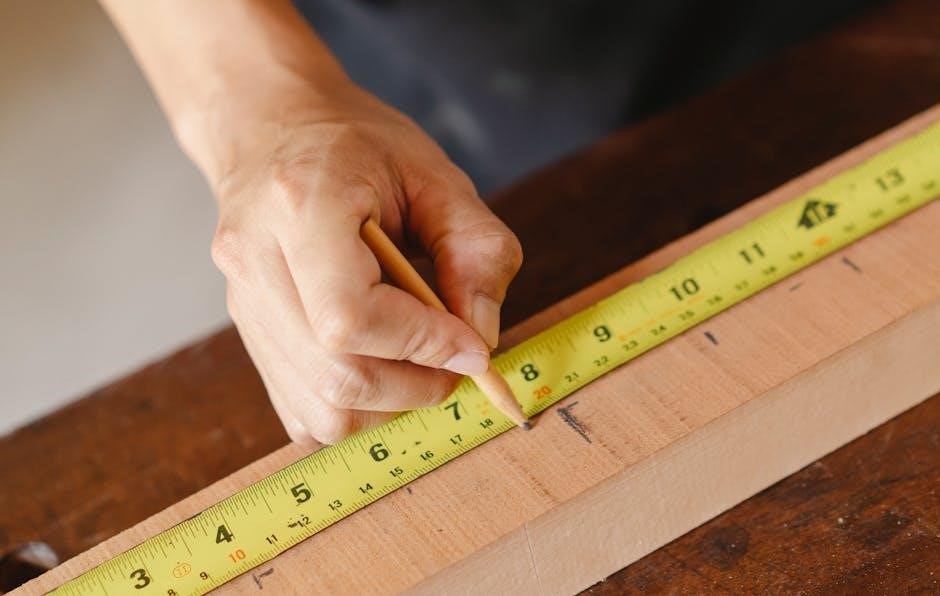Japanese joinery is an ancient craft emphasizing precision and aesthetics without nails or bolts. It combines functionality with art, making it a meditative process for beginners and masters alike.
1.1 What is Japanese Joinery?
Japanese joinery is a traditional woodworking technique that creates strong, durable structures without nails or glue. It relies on intricate cuts and interlocking parts, emphasizing precision and craftsmanship. This method, rooted in Japanese culture, combines functionality with aesthetic beauty. Key techniques include mortise and tenon, dovetail, and lap joints, each requiring skill and patience. The process involves careful wood selection, tool preparation, and a deep understanding of wood behavior. It is both a practical and meditative art, reflecting Japan’s reverence for nature and simplicity.
1.2 Historical Context and Cultural Significance
Japanese joinery traces its roots to ancient Japan, where it was integral to constructing temples, shrines, and traditional homes. This craft reflects the cultural values of harmony with nature, precision, and reverence for craftsmanship. Historically, it was passed down through generations of skilled artisans, embodying the “shokunin” spirit of mastery and dedication. The technique not only ensured structural integrity but also symbolized the pursuit of perfection and the integration of form and function, deeply influencing both traditional and modern Japanese design.

Essential Tools for Japanese Joinery
Traditional tools like Japanese saws, chisels, and marking gauges are vital. Modern beginners often use jigs and power tools for precision and ease in mastering joints.
2.1 Traditional Japanese Woodworking Tools
Traditional Japanese woodworking relies on hand tools like the ryoba (double-edged saw) and dozuki (dovetail saw) for precise cuts. Chisels (nomi) are used for removing wood, while sumitsubo (ink line markers) ensure accurate layouts. The kanna (Japanese plane) smooths surfaces flawlessly. These tools, often passed down through generations, embody the craftsmanship and mindfulness central to Japanese joinery. Their design reflects centuries of refinement, making them indispensable for achieving the joints’ seamless integration and beauty.
2.2 Modern Tools for Beginners
Modern tools simplify Japanese joinery for beginners, blending tradition with convenience. Electric saws and routers enhance precision, while dowelling jigs ensure accurate joint alignment. Combination squares and marking gauges aid in measuring and layout. These tools offer accessibility and efficiency, making intricate joints achievable without years of practice. They cater to newcomers, providing a bridge between traditional techniques and contemporary woodworking practices.

Basic Japanese Joints for Beginners
Japanese joinery for beginners starts with essential joints like the Mortise and Tenon, known for strength, the Dovetail for durability, and the simple Lap Joint for quick projects.
3.1 Mortise and Tenon Joint
The Mortise and Tenon Joint is a cornerstone of Japanese joinery, offering exceptional strength and versatility. It consists of a mortise (a recessed area in one piece) and a tenon (a projecting part on the other). This joint is widely used in traditional Japanese architecture and furniture-making, requiring precise cutting and fitting. Its simplicity and durability make it ideal for beginners to practice, while its aesthetic appeal aligns with the minimalist ethos of Japanese design. Mastering this joint is essential for progressing in Japanese woodworking.
3.2 Dovetail Joint
The Dovetail Joint is a classic woodworking technique, popular in both Western and Japanese carpentry. It features interlocking tails and pins, providing exceptional strength and resistance to pulling forces. In Japanese joinery, this joint is often used for constructing drawers and cabinets, where durability and precision are crucial. While the dovetail joint can be challenging for beginners, its mastery enhances one’s skill set in woodworking. With practice, it becomes a fundamental element in creating beautiful and functional pieces, reflecting the harmony of Japanese design.
3.3 Lap Joint
The Lap Joint is a simple yet effective technique in Japanese joinery, involving the overlap of two wood pieces. It is commonly used in traditional Japanese architecture for framing and cabinetry. This joint is ideal for beginners due to its straightforward execution, requiring minimal tools. The Lap Joint ensures strength and stability through precise alignment, making it a versatile choice for various woodworking projects. Its simplicity allows for quick assembly and disassembly, a feature often appreciated in Japanese designs. Mastering this joint is a great way to build foundational skills in Japanese joinery.

Step-by-Step Guide to Making Japanese Joints
Making Japanese joints involves precise preparation and execution. Start by carefully cutting and fitting each piece, ensuring alignment and accuracy. Practice and patience are key to mastering these techniques.
4;1 Preparing Wood and Tools
Preparing wood and tools is crucial for successful Japanese joinery. Select straight-grained, dry wood to ensure accuracy and prevent warping. Sharpen tools like chisels and saws meticulously, as dull tools can ruin joints. Use ink for marking, as it provides finer lines than chalk. Organize your workspace to maintain focus and efficiency. Proper preparation ensures precise cuts and fits, laying the foundation for mastering Japanese joints. Safety and patience are essential during this initial phase.
4.2 Cutting and Fitting Joints
Cutting and fitting joints requires precision and patience. Use Japanese saws to make clean, accurate cuts, ensuring minimal waste. Start with the mortise, carefully removing wood to the desired depth. For tenons, cut slightly oversized and refine with chisels. Test the fit repeatedly, adjusting with light strokes to achieve a snug, seamless connection. Use clamps to hold pieces in place while checking alignment. Sand joints to remove splinters and ensure smooth integration. Practice and attention to detail are key to mastering this step in Japanese joinery.

Troubleshooting Common Mistakes
Address uneven cuts by refining techniques and using proper tools. Misaligned joints can be fixed with careful chisel adjustments and patience, ensuring a seamless final fit.
5.1 Avoiding Uneven Cuts
Achieving even cuts is crucial in Japanese joinery. Beginners should use sharp, well-maintained tools and proper sawing techniques. Marking with ink ensures precise lines, reducing errors. Cutting on the pull stroke, as traditional Japanese woodworkers do, improves control. Use a marking gauge for consistent measurements. Clamp wood firmly to prevent movement. Practice on scrap wood to refine skills. Regularly sharpen tools to maintain accuracy. By mastering these steps, beginners can minimize uneven cuts and achieve professional-quality joints.
5.2 Fixing Misaligned Joints
Misaligned joints can be corrected by carefully assessing the issue. Use a chisel or hand plane to adjust the mortise or tenon. Shimming with thin wood or paper can realign joints. Apply minimal force to avoid further damage. Ensure tools are sharp for precise adjustments. Patience is key, as fixing misalignments requires careful refinement. Regular practice helps improve accuracy, reducing the need for corrections. Proper tool maintenance and precise measurements are essential for achieving perfectly aligned joints in Japanese joinery.
Historical and Modern Applications
Japanese joinery historically shaped iconic structures like temples and Shoji screens. Today, it inspires modern furniture and design, blending tradition with contemporary aesthetics and functionality. Precision meets artistry.
6.1 Traditional Japanese Architecture
Traditional Japanese architecture, such as temples, shrines, and tea houses, heavily relies on intricate joinery techniques. These structures showcase seamless joints like the mortise and tenon, eliminating the need for nails. Shoji screens and sliding doors exemplify precision craftsmanship, blending functionality with aesthetic simplicity. The use of natural materials and invisible fasteners reflects the cultural emphasis on harmony and durability. These designs have preserved traditional methods for centuries, inspiring modern adaptations while maintaining their historical essence.
6.2 Modern Uses in Furniture and Design
Japanese joinery techniques are increasingly applied in modern furniture and design, blending tradition with contemporary aesthetics. Craftsmen use timeless joints like the mortise and tenon to create sleek, minimalist pieces. Shoji screens inspire modern partition designs, while dovetail joints enhance cabinetmaking. The fusion of traditional methods with modern materials, such as steel and glass, creates innovative, functional pieces. This blend of old and new appeals to designers seeking sustainable, eco-friendly solutions, ensuring Japanese joinery remains relevant in today’s design landscape.
Mastery of Japanese joinery requires patience and practice. Continue refining your skills, explore advanced techniques, and delve into historical applications to deepen your understanding of this timeless craft.
7.1 Practicing and Mastering Japanese Joinery
Consistent practice is essential for mastering Japanese joinery. Start with simple joints like the mortise and tenon, gradually progressing to more complex designs. Pay attention to precision and patience, as these are the cornerstones of this craft. Troubleshoot common mistakes, such as uneven cuts or misaligned joints, by refining your technique and tool skills. Explore resources like the Beginner’s Guide to Japanese Joinery PDF for step-by-step guidance and inspiration. Over time, you’ll develop the mastery needed to create breathtaking, durable pieces that reflect the beauty of traditional Japanese woodworking.
7.2 Exploring Advanced Techniques
As you gain confidence, delve into advanced Japanese joinery techniques like intricate kumiko patterns and multi-piece joints. These methods require precision and patience but offer unparalleled aesthetic and structural rewards. Resources such as The Complete Japanese Joinery PDF provide detailed insights into complex designs. Experiment with traditional tools and explore historical architectures to inspire your projects. Advanced techniques not only challenge your skills but also deepen your appreciation for the artistry and functionality of Japanese woodworking.
Additional Resources
Explore comprehensive guides like Beginners Guide to Japanese Joinery PDF and Japanese Woodworking: A Beginners Guide by Sean Graham for in-depth techniques and projects. Online tutorials and woodworking communities also offer valuable insights and support for mastering Japanese joinery.
8.1 Recommended Books and Guides
For beginners, essential books include Beginners Guide to Japanese Joinery by Jin Izuhara, offering step-by-step joint making. Japanese Woodworking: A Beginners Guide by Sean Graham provides a comprehensive introduction. The Complete Japanese Joinery by Hideo Sato is a detailed resource. These guides cover techniques, tools, and projects, ideal for mastering traditional and modern Japanese joinery methods. They are available in PDF formats, making them accessible for easy learning and reference.
8.2 Online Tutorials and Communities
Online tutorials and communities offer valuable resources for mastering Japanese joinery. Websites like YouTube host video guides by experts, while platforms like Instructables provide detailed step-by-step projects. Reddit’s woodworking communities and specialized forums share tips and solutions. Skillshare and Udemy offer courses tailored for beginners. These resources complement PDF guides, offering interactive learning and real-time feedback. They are essential for hands-on practice and staying connected with enthusiasts and professionals in the field of Japanese woodworking.
